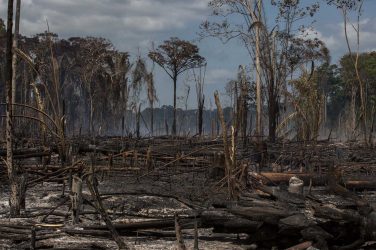Brazil’s government announced a major shift away from its policy of building mega-dams in the Brazilian Amazon – a strategy born during the country’s military dictatorship (1964-1985) and vigorously carried forward down to the present day.
The Temer government claims the decision is a response to intense resistance from environmentalists and indigenous groups, but while that may be part of the reason, experts see other causes as well.
The decline in political influence of Brazil’s gigantic construction companies caused by the Lava Jato (Car Wash) corruption investigation is likely a major cause of the change in policy.
So is the current depressed state of Brazil’s economy, which makes it unlikely that Brazil’s huge development bank (BNDES) will invest in such multi-billion dollar projects.
While environmentalists and indigenous groups will likely celebrate the shift away from the mega-dam policy, experts warn that many threats to the Amazon remain, including pressure by Brazil’s ruralist lobby to open up conserved areas and indigenous lands to agribusiness, along with threats posed by new road, rail, waterway and mining projects.
In a surprise move, the Brazilian government has announced that the era of building big hydroelectric dams in the Amazon basin, long criticized by environmentalists and indigenous groups, is ending.
“We are not prejudiced against big [hydroelectric] projects, but we have to respect the views of society, which views them with restrictions,” Paulo Pedrosa, the Executive Secretary of the Ministry of Mines and Energy, told O Globo newspaper.
According to Pedrosa, Brazil has the potential to generate an additional 50 gigawatts of energy by 2050 through the building of new dams but, of this total, only 23 percent would not affect in some way indigenous land, quilombolas (communities set up by runaway slaves) and federally protected areas. The government, he says, doesn’t have the stomach to take on the battles.
Pedrosa went on: “Nor are we disposed to take actions that mask the costs and the risks [of hydroelectric projects].” This statement seems to refer to the actions of previous governments, particularly under President Dilma Rousseff and the Workers’ Party (PT), which made it difficult to evaluate the real expense and environmental impact of large dams, such as Belo Monte on the Xingu River. It was only after construction of this particular dam that the huge cost – financial, social and environmental – was fully revealed.
That’s one reason such mega-projects began meeting with a rising storm of protest. For example, in 2016, after many indigenous demonstrations, the Rousseff administration suspended the building of a large dam on the Tapajós river – São Luiz do Tapajós – which would have flooded part of the Munduruku indigenous territory of Sawre-Muybu.
However, because the government never officially canceled the dam, Indians and environmentalists have long feared that the project could be relaunched at any moment by the Temer administration. However, according to O Globo, the Ministry of Mines and Energy has announced that it will “no longer fight for the [São Luiz do Tapajós] project.”
“I don’t think any more big hydro dams will be built,” said Mauro Maura Severino, a lecturer in electric energy at the University of Brasília. “Brazil should move towards clean energy, like solar and wind.”
João Carlos Mello, from Thymos Energia, a consulting company, agreed: “The future lies with renewable energy, such as wind, and much smaller dams. The tendency will be to generate the energy much nearer to where it will be consumed.”
While the Temer administration hasn’t said so, experts say there is no doubt that hard economic realities played a chief role in the government’s turnabout.
In the past, the huge Brazilian development bank, BNDES (National Bank of Economic and Social Development), subsidized mega-dams to the tune of billions of dollars, funneling the money through state companies, which became powerful as a result.
For example, Eletrobrás, Latin America’s biggest utility company, owns 49.98 percent of Belo Monte. Furnas, a regional power utility and Eletrobras subsidiary, owns 39 percent of the Santo Antônio hydroelectric project and, through its subsidiaries, 40 percent of the Jirau dams – both large, controversial projects built on the Madeira River.
However, in August of last year, Temer stunned the market by announcing the privatization of Eletrobras. Edvaldo Santana, the former director of ANEEL (the National Agency of Electric Energy), said:
“The privatization of Eletrobrás is a relevant factor [in the change of policy regarding mega-dams]. Neither Belo Monte nor Santo Antônio nor Jirau would have existed – or would have taken much longer to build – without Eletrobras” and the infusion of cash from BNDES.
Brazil’s political climate has also changed since the heyday of mega-dam construction under presidents Lula and Rousseff. By 2016, for example, when Mongabay wrote a series of articles about BNDES and its funding of the big Amazon dams, it could no longer find anyone – not even an engineer or an energy expert – willing to defend the Belo Monte dam.
Although few were willing to speak on record then, many agreed that the only reason Belo Monte was built was because the PT government needed a big construction project by which the political party could pay back the big construction companies, like Odebrecht, for the huge sums in illegal electoral campaign contributions the firms had provided.
Such deals are no longer possible thanks to the far-reaching corruption scandal known as Lava-Jato (Car Wash) that ensnared a vast swath of Brazil’s political and business elite, including top executives from major construction companies. Investigations are ongoing.
Back in 2016, Felício Pontes, a MPF Prosecutor in the state of Pará, said: “The factor that explains the irrational option for hydroelectric stations in the Amazon is corruption… In other words, energy planning in Brazil is not treated as a strategic issue involving the future of the nation but, at least since the time of the military dictatorship, as a source of money for construction companies and politicians. I think that, until these questions are exposed and resolved, we will continue to have expensive and inefficient dams that have a serious social and environmental impact in Amazonia.”
The government’s hydroelectric dams policy change announced this week will surely be greeted as a hopeful sign by environmentalists and indigenous groups. But experts warn that a much bigger strategic policy shift is needed regarding infrastructure planning and agribusiness before the Amazon can be deemed safe from major deforestation.
Over the last 18 months, the bancada ruralista, the rural lobby in Congress, has won victory after victory, leading to policies meant to benefit agribusiness while threatening conservation units and indigenous territories.
That drive seems likely to intensify in the months leading up to October’s presidential election. There is, for example, still talk of a hugely environmentally harmful project that would turn the Tapajós river basin into an industrial waterway, with its tributaries and main stem dredged and rapids dynamited.
Hydroelectric dams have caused great damage to indigenous and traditional communities and the environment, but they are only one of many serious Amazon threats – new roads, railways, waterways, mines and other infrastructure all result in great destruction.
While the just-announced shift in hydropower policy is important, experts agree that major changes are needed before one can talk of a real conservation breakthrough in the Brazilian Amazon.
This article appeared originally in Mongabay – https://news.mongabay.com














